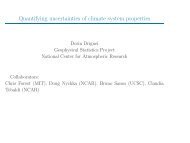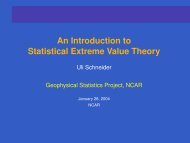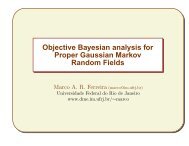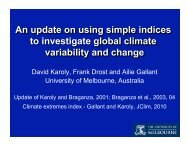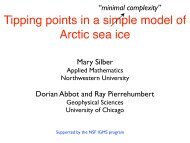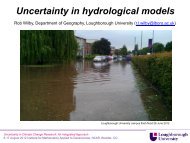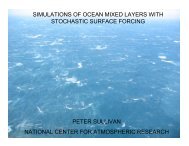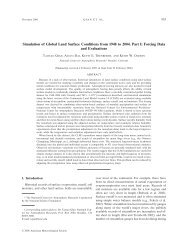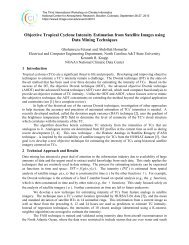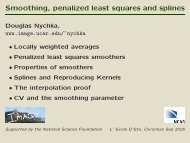A Spatial Analysis of Multivariate Output from Regional ... - IMAGe
A Spatial Analysis of Multivariate Output from Regional ... - IMAGe
A Spatial Analysis of Multivariate Output from Regional ... - IMAGe
Create successful ePaper yourself
Turn your PDF publications into a flip-book with our unique Google optimized e-Paper software.
a great deal <strong>of</strong> flexibility in modeling the conditional-dependence structure and is easilyextendable. For example, more complex neighborhood structures can be considered (e.g.,Sain et al., 2007), and it is not difficult to conceptualize how one might even consider modelingthe joint distribution <strong>of</strong> multiple variables that are on different lattices. Connectionsto graphical models (e.g., Whittaker, 1990) could lead to further insights into modelingand parameter estimation. The computational impact and practical utility <strong>of</strong> consideringadditional variables (increasing p) or additional ensemble members (increasing m) is also<strong>of</strong> interest, although, at least in climate model research, these are highly dependent onthe application and the computational demands associated with running climate modelson high-performance computers. These are issues that we are currently considering. Wealso note that this work adds to a growing collection <strong>of</strong> research involving the study andmodeling <strong>of</strong> asymmetric cross-dependence structures for multivariate spatial data, including,for example, Jin et al. (2005) and Sain and Cressie (2007) in the case <strong>of</strong> MRFs andRoyle and Berliner (1999), Ver Hoef et al. (2004), and Apanasovich and Genton (2010) forgeostatistical data.There is great interest in more complex ensembles, such as perturbed-physics experimentsand multi-model ensembles. We have not considered such ensembles here as we havefocused on the multivariate aspect <strong>of</strong> the analysis <strong>of</strong> simple ensembles <strong>of</strong> regional-climatemodeloutput. However, the model presented here could be extended to consider suchensembles by straightforward modifications to the process model, in particular Eqn. (8)could be modified to allow for a spatial meta-analysis component (e.g., Kang et al., 2010)or through a functional analysis <strong>of</strong> variance similar to that <strong>of</strong> Kaufman and Sain (2010).Aside <strong>from</strong> the obvious computational challenges to simply fitting such models in the multivariatesetting, there is, <strong>of</strong> course, more work needed to quantify the variation associatedwith different model physics or different models.It is important to note that any conclusions taken <strong>from</strong> an analysis such as the oneconsidered here are conditional on the assumptions implicit to the particular climate modelor models used to generate the output fields. Whether global or regional in nature, climate29



